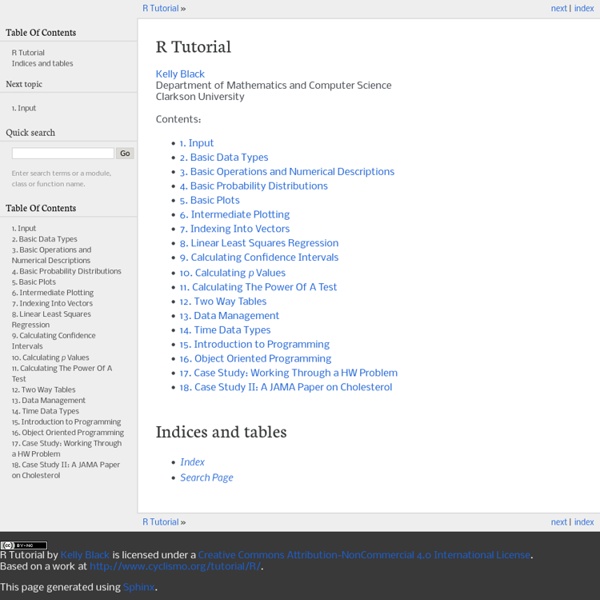



How to use R R is a powerful, free and open source, cross-platform, statistical and graphing software package;programming language;software environment for statistical computing. Downloading R[edit] Visit the R Project home page. Tutorials[edit] Books that are Helpful When Learning R[edit] See also[edit] External links[edit] Books[edit] Code School - Try R Online Statistics Education: A Free Resource for Introductory Statistics R by example Basics Reading files Graphs Probability and statistics Regression Time-series analysis All these examples in one tarfile. Outright non-working code is unlikely, though occasionally my fingers fumble or code-rot occurs. Other useful materials Suggestions for learning R The R project is at : In particular, see the `other docs' there. Over and above the strong set of functions that you get in `off the shelf' R, there is a concept like CPAN (of the perl world) or CTAN (of the tex world), where there is a large, well-organised collection of 3rd party software, written by people all over the world. The dynamism of R and of the surrounding 3rd party packages has thrown up the need for a newsletter, R News. library(help=boot) library(boot) ? But you will learn a lot more by reading the article Resampling Methods in R: The boot package by Angelo J. Ajay Shah, 2005
Falcor: One Model Everywhere One Model Everywhere Falcor lets you represent all your remote data sources as a single domain model via a virtual JSON graph. You code the same way no matter where the data is, whether in memory on the client or over the network on the server. The Data is the API A JavaScript-like path syntax makes it easy to access as much or as little data as you want, when you want it. You retrieve your data using familiar JavaScript operations like get, set, and call. Bind to the Cloud Falcor automatically traverses references in your graph and makes requests as needed. Getting Started You can check out a working example server for a Netflix-like application here right now. Creating a Virtual JSON Resource In this example we will use the Falcor Router to build a Virtual JSON resource on an app server and host it at /model.json. Normally Routers retrieve the data for their Virtual JSON resource from backend datastores or other web services on-demand. First we create a folder for our application server.
An Interactive Introduction To R (Programming Language For Statistics) Statistics with R Warning Here are the notes I took while discovering and using the statistical environment R. However, I do not claim any competence in the domains I tackle: I hope you will find those notes useful, but keep you eyes open -- errors and bad advice are still lurking in those pages... Should you want it, I have prepared a quick-and-dirty PDF version of this document. The old, French version is still available, in HTML or as a single file. You may also want all the code in this document. 1. This work is licensed under a Creative Commons Attribution-NonCommercial-ShareAlike 2.5 License.
cola.js: Constraint-based Layout in the Browser Data Transformations and Manipulation in SAS SAS LibraryData Transformations and Data Manipulation in SAS This page was adapted from a page created by Professor Oliver Schabenberger . We thank Professor Schabenberger for permission to adapt and distribute this page via our web site. 1. 1. Manipulating data is possible in the initial DATA step when you read in or access data for the first time or in subsequent data steps when you modify or replace an existing data set. data mydata; set mydata; < more statements> run; and data newdata; set mydata; <more statements> run; The SET command adds the contents of a data set to a DATA step. 2. SAS' power makes it unnecessary to perform most data manipulations outside of The SAS System. This DATA step calculates various transformations of the income variable. For more information about mathematical, trigonometric, and other functions see the Help Files (go to Help-Extended Help, then select SAS System Help, select SAS Language, select SAS Functions, select Function Categories) 2.2. 2.3. 3.
R Programming - Wikibooks, collection of open-content textbooks Welcome to the R programming Wikibook This book is designed to be a practical guide to the R programming language[1]. R is free software designed for statistical computing. There is already great documentation for the standard R packages on the Comprehensive R Archive Network (CRAN)[2] and many resources in specialized books, forums such as Stackoverflow[3] and personal blogs[4], but all of these resources are scattered and therefore difficult to find and to compare. How can you share your R experience ? Explain the syntax of a commandCompare the different ways of performing each task using R.Try to make unique examples based on fake data (ie simulated data sets).As with any Wikibook please feel free to make corrections, expand explanations, and make additions where necessary. Some rules : Prerequisites[edit] We assume that readers have a background in statistics. We also assume that readers are familiar with computers and that they know how to use software with a command-line interface.
Big Data, Data Mining, Predictive Analytics, Statistics, StatSoft Electronic Textbook This free ebook has been provided as a public service since 1995. Statistics: Methods and Applications textbook offers training in the understanding and application of statistics and data mining. It covers a wide variety of applications, including laboratory research (biomedical, agricultural, etc.), business statistics, credit scoring, forecasting, social science statistics and survey research, data mining, engineering and quality control applications, and many others. The Textbook begins with an overview of the relevant elementary (pivotal) concepts and continues with a more in depth exploration of specific areas of statistics, organized by "modules", representing classes of analytic techniques. You have filtered out all documents.